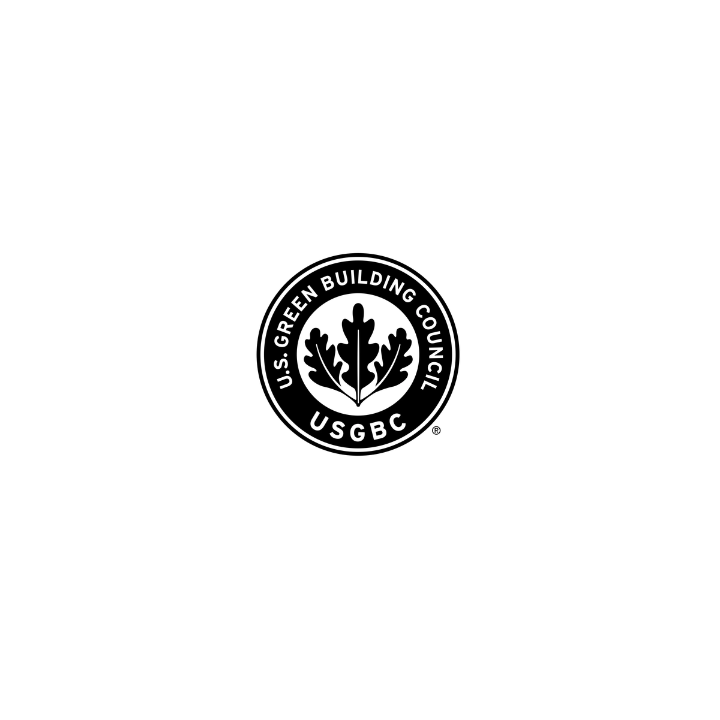USGBC – U.S. Green Building Council
The Values
Mission and vision
The USGBC is committed to transforming how our buildings are designed, constructed and operated through LEED, because they believe that every person deserves a better, more sustainable life.
Their vision is that buildings and communities will regenerate and sustain the health and vitality of all life within a generation. Their mission is to transform the way buildings and communities are designed, built and operated, enabling an environmentally and socially responsible, healthy, and prosperous environment that improves the quality of life.
Today people know that if they are in a LEED-certified building they are using less energy and water, avoiding waste, saving on maintenance costs, improving indoor air quality, offering comfort to their occupants, and creating less environmental burden on their community. They also know that they are in a building that enhances health and wellness. Now green building has grown into a trillion-dollar industry, and LEED has become the most widely used green building program in the world. View the 2017-19 Strategic Plan.
The Story
LEED’s goal is green building for everyone.
Where LEED began
In April 1993, Rick Fedrizzi, David Gottfried and Mike Italiano convened representatives from 60 firms and several nonprofits in the American Institute of Architects’ boardroom for the founding meeting. It was then that ideas were shared for an open and balanced coalition spanning the entire building industry and for a green building rating system, which would later become LEED.
1993
The early years
The 1990s saw a growing realization of the need to optimize these systems—with people and nature in mind—to create better buildings.
LEED’s development grew from the formation of USGBC in 1993 by three individuals: David Gottfried, Mike Italiano and Rick Fedrizzi, who served as president, CEO and founding chair of the organization.
1998
LEED v1.0
By 1998, USGBC had successfully developed LEED 1.0, and it began pilot testing 19 projects.
Following the success of the pilot program, LEED for New Construction saw a public launch in March 2000.
2001
LEED v2.0 and Greenbuild
In March 2001, drawing on lessons learned from the pilot program, USGBC launched LEED 2.0.
Furthering its movement into new market sectors, USGBC saw the first elementary school achieve LEED Gold, Third Creek Elementary in Statesville, N.C., in November 2002. Meanwhile, as a reflection of the excitement and demand within the green building industry, USGBC hosted the first-ever Greenbuild International Conference and Expo that same month in Austin, Texas, with approximately 4,000 attendees.
2003
A green building explosion
2003 saw a number of significant developments for LEED. USGBC had grown and matured from its start as a fledgling non-profit, gathering strength, staff and resources, and it had launched LEED v2.1 the previous year. In April, LEED for Existing Buildings and LEED for Commercial Interiors both began pilot testing, while in October, LEED for Core and Shell launched. In November, the National Geographic Society building in Washington, D.C, became the first LEED-certified existing building.
In April 2004, LEED reached a significant milestone: 100 certified projects.
2009
LEED v2009
USGBC launched LEED v2009 in April 2009. Among the many improvements over its predecessor, LEED v2.2, LEED v2009 introduced weightings for credits based on the Environmental Protection Agency’s TRACI (Tool for the Reduction and Assessment of Chemical and Other Environmental Impacts) and weightings developed by the National Institute of Standards. This advancement made LEED much more rigorous and indicated which credits were most important. For the first time there was objective scientific intentions behind the assigned credit values.
That same year, USGBC moved into its new headquarters at 2101 L St. NW, a Platinum-certified LEED for Commercial Interiors space, the first project to certify under LEED v2009 and a showcase of sustainable interior design. In 2010, GBCI certified the 5000th LEED project.
2015
LEED v4
LEED v4 came in 2015 with a lot of new improvements over the previous systems, including increased flexibility, a performance-based, smart grid approach, an emphasis on materials and resources, a comprehensive approach to water, and streamlined documentation. LEED v4 continued to raise the bar for green buildings.
2019
LEED v4.1 and a new Living Standard
LEED v4.1 is for all – it is more inclusive with updated referenced standards and allows projects to earn LEED points through building performance monitoring. It also continues to drive performance, fully integrating performance outcomes supported by new methodologies and a simple data-driven path to measure performance on an ongoing basis. Lessons learned from those using LEED have led us to take a deeper look at existing buildings, residential projects and cities to develop solutions that address unique markets.
Living Standard is about connecting green buildings and LEED, and connecting our products to people. Through this campaign, we aim to listen to our communities, share their stories, and build a vision for a more sustainable future for all by making visible the tangible and positive impacts that green buildings and green communities have on our lives.
USGBC created LEED to measure and define what green building meant, and to provide a roadmap for developing sustainable buildings. With LEED, we established a baseline—a universally agreed upon holistic system for reducing environmental impact.
Phone +49 711 62049-340
Email info@hoinka.com


